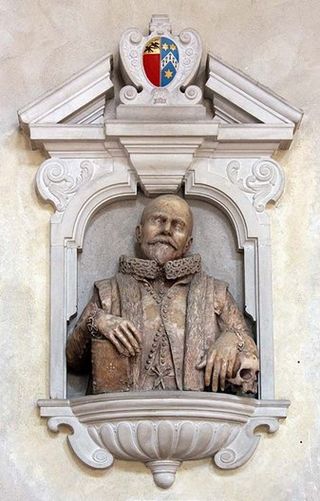Related Research Articles

A corporation is an organization—usually a group of people or a company—authorized by the state to act as a single entity and recognized as such in law for certain purposes. Early incorporated entities were established by charter. Most jurisdictions now allow the creation of new corporations through registration. Corporations come in many different types but are usually divided by the law of the jurisdiction where they are chartered based on two aspects: whether they can issue stock, or whether they are formed to make a profit. Depending on the number of owners, a corporation can be classified as aggregate or sole.

John Speed was an English cartographer, chronologer and historian of Cheshire origins. The son of a citizen and Merchant Taylor in London, he rose from his family occupation to accept the task of drawing together and revising the histories, topographies and maps of the Kingdoms of Great Britain as an exposition of the union of their monarchies in the person of King James I and VI. He accomplished this with remarkable success, with the support and assistance of the leading antiquarian scholars of his generation. He drew upon and improved the shire maps of Christopher Saxton, John Norden and others, being the first to incorporate the hundred-boundaries into them, and he was the surveyor and originator of many of the town or city plans inset within them. His work helped to define early modern concepts of British national identity. His Biblical genealogies were also formally associated with the first edition of the King James Bible. He is among the most famous of English mapmakers.

Hector Boece, known in Latin as Hector Boecius or Boethius, was a Scottish philosopher and historian, and the first Principal of King's College in Aberdeen, a predecessor of the University of Aberdeen.

Sir Francis Windebank was an English politician who was Secretary of State under Charles I.
Gilbert Eric Cannan was a British novelist and dramatist.

John Weever (1576–1632) was an English antiquary and poet. He is best known for his Epigrammes in the Oldest Cut, and Newest Fashion (1599), containing epigrams on Shakespeare, Ben Jonson, and other poets of his day, and for his Ancient Funerall Monuments, the first full-length book to be dedicated to the topic of English church monuments and epitaphs, which was published in 1631, the year before his death.
Henry Dunning Macleod was a Scottish economist and lawyer.
James Anderson was a Scottish writer and minister born and educated in Aberdeen, Scotland. He was ordained a minister in the Church of Scotland in 1707 and moved to London, where he ministered to the Glass House Street congregation until 1710, to the Presbyterian church in Swallow Street until 1734, and at Lisle Street Chapel until his death. He is reported to have lost a large sum of money in the South Sea Company crash of 1720. Anderson is best known for his association with Freemasonry.
David Wilkins (1685–1745), originally named Wilke or Wilkius, was a Prussian orientalist, born in Memel, who settled in England. His 1716 publication of the Coptic New Testament was the editio princeps.

Thomas Neale (1641–1699) was an English project-manager and politician who was also the first person to hold a position equivalent to postmaster-general of the North American colonies.

The Royal Exchange Assurance, founded in 1720, was a British insurance company. It took its name from the location of its offices at the Royal Exchange, London.
James Cunningham, 7th Earl of Glencairn (1552–1630) was a Scottish peer and member of the Privy Council of Scotland.
The York Buildings Company was an English company in the late 17th and early 18th centuries.

A claymore is either the Scottish variant of the late medieval two-handed sword or the Scottish variant of the basket-hilted sword. The former is characterised as having a cross hilt of forward-sloping quillons with quatrefoil terminations and was in use from the 15th to 17th centuries.
The Courteen association, later called the Assada company was an English trading company founded in 1635 in an attempt to break the monopoly of the East India Company in trade with India.
William Robert Scott was a political economist who was Adam Smith Professor of Political Economy at the University of Glasgow from 1915 to 1940.
The lists of English translations from medieval sources provide overviews of notable medieval documents—historical, scientific, ecclesiastical and literary—that have been translated into English. This includes the original author, translator(s) and the translated document. Translations are from Old and Middle English, Old French, Irish, Scots, Old Dutch, Old Norse or Icelandic, Italian, Latin, Arabic, Greek, Persian, Syriac, Ethiopic, Coptic, Armenian, Hebrew and German, and most works cited are generally available in the University of Michigan's HathiTrust digital library and OCLC's WorldCat. Anonymous works are presented by topic.
References
- ↑ Smyth, Adam (2010). Autobiography in Early Modern England. Cambridge University Press. pp. 62–64. ISBN 9780521761727.
- ↑ Richards, R.D (February 1926). "Early History of the Term Capital". The Quarterly Journal of Economics. 40 (2): 329–338. doi:10.2307/1884622. JSTOR 1884622.
- ↑ Scott, W. R. (December 1910) (December 1910). Constitution and Finance of English, Scottish and Irish Joint Stock Companies to 1720. Cambridge University Press.
{{cite book}}: CS1 maint: numeric names: authors list (link)